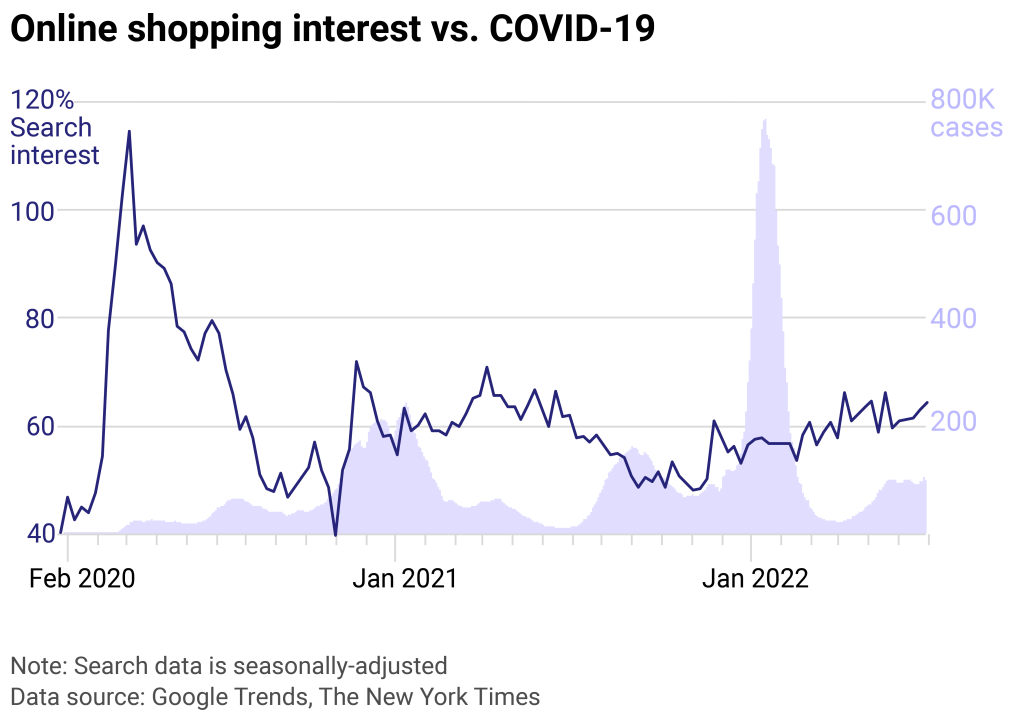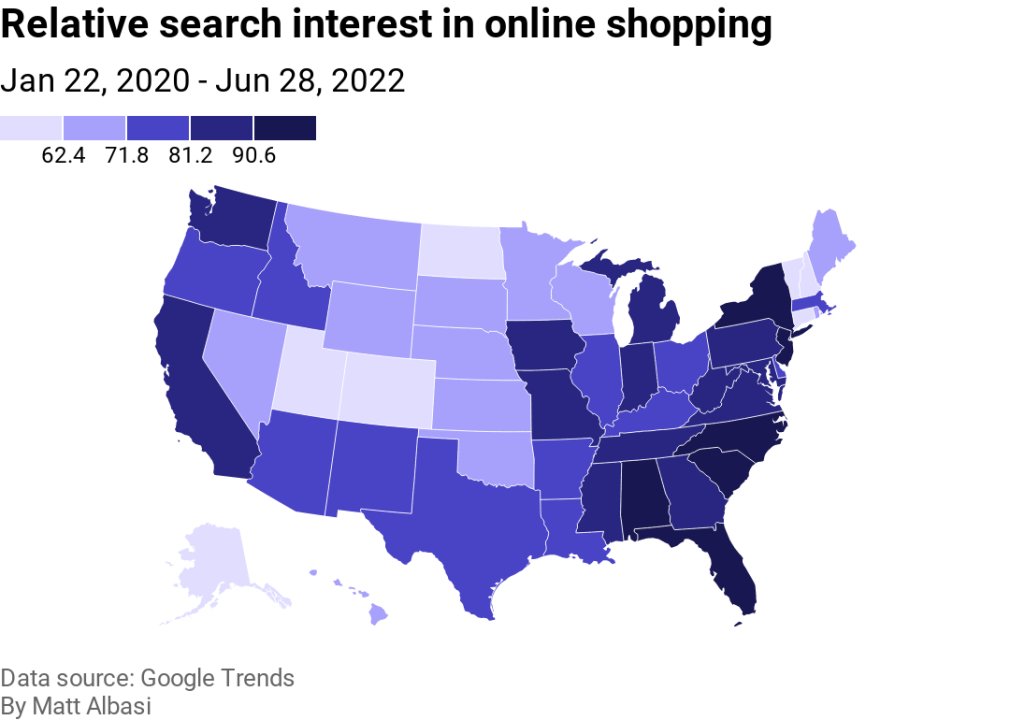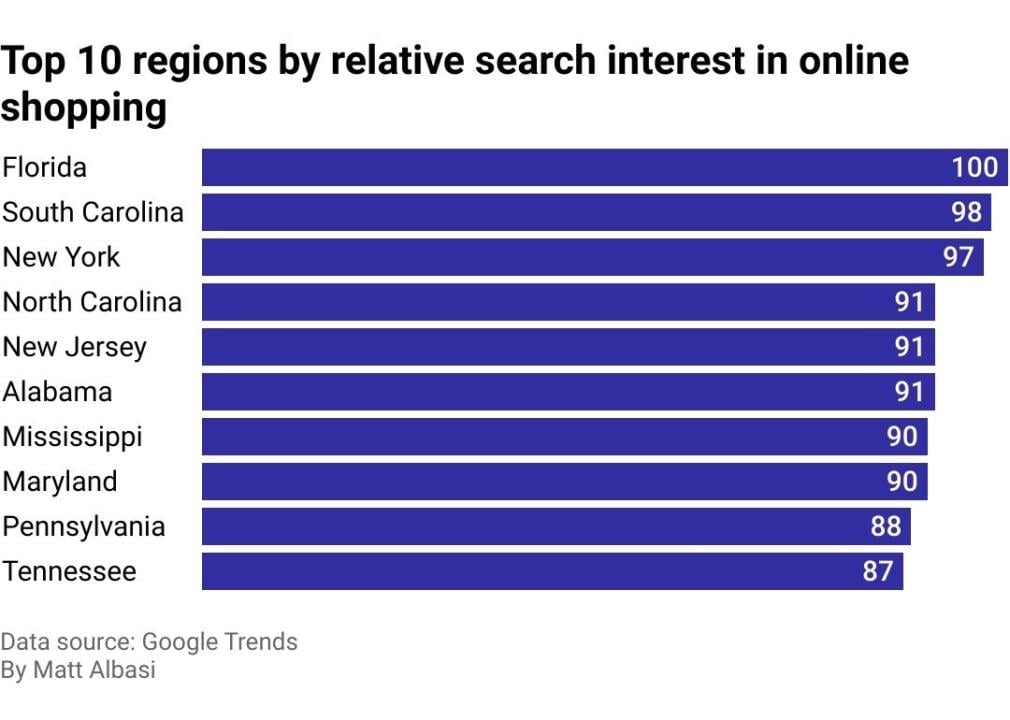
How online spending habits changed in every state during COVID-19
American shopping habits as a whole will never be quite the same as they were prior to the global COVID-19 pandemic. Risk of catching the novel virus that causes COVID-19 kept consumers out of public spaces for much of 2020 and 2021 as the U.S. developed and distributed vaccines. And while people were home, they turned to smartphones and computers to do their shopping.
Google Trends data suggest that online shopping interest hit its peak in the first week of April 2020. Each subsequent spike in online shopping interest was slightly lower.
Grocery retail is just one of the industries that saw consumers shift shopping habits online over the last several years. Online grocery shopping was in its infancy just two years ago. Grocers had released mobile apps, but consumers had yet to shift their habits to take advantage of the convenient new ways to purchase food and other household necessities. In 2020, food retailers embraced mobile ordering, delivery, and curbside pickup—and consumers followed along, whether out of concern for health or convenience.
Not every industry benefited from the pandemic shift to e-commerce like grocers. Clothing retailers saw sales drop in 2020, while sporting goods retailers saw sales grow compared with pre-pandemic levels, according to Census data.
Looking forward, some online shopping habits developed in the last two years are proving stickier than others. For example, demand remains high for curbside pickup orders—a pandemic-era service that data has shown could be here to stay. While grocery delivery declined in 2021 compared to 2020, curbside pickup sales grew, according to market research firm Brick Meets Click and e-commerce platform Mercatus.
Giving Assistant collected and examined data from Google Trends and The New York Times to understand how interest in online shopping changed over the course of the pandemic.
This story looks at Google Trends data from Jan. 26, 2020, until June 28, 2022, to show the search volume for terms related to the topic “online shopping” within the “shopping” category. The values are relative to the total search volume on Google. The data is normalized and shown on a scale of 1 to 100 with each point being divided by the highest point.
While Google doesn’t share the exact terms that go into this topic and category, they show terms that are most frequently searched with this topic, like “clothes shopping online” and “online sales.” COVID-19 data comes from The New York Times Coronavirus Data in the United States repository.

As COVID increased, people’s interest in shopping online peaked
Data from Google Trends shows that nearly every time COVID-19 cases spiked in the U.S., Americans turned to the internet en masse to shop. Over the 2.5-year period analyzed, interest in online shopping spiked for several months around each increase in cases and then subsided somewhat—although still above pre-pandemic levels of interest—before rising again with the next wave of COVID infections. A downward sloping line could also mean search interest rose for other terms.

Online shopping interest was strongest in the East
Relative interest in online shopping was highest in regions with more densely-packed populations—particularly on the East Coast. States in New England, the Midwest, and some landlocked Western states showed the least interest over the two-year period.

Most interest in online shopping centered in Florida and South Carolina
Florida, South Carolina, and New York consumers were the most engaged in online shopping, according to search interest data from Google Trends. As sunny Florida and South Carolina are both major destinations for retirees—including those who were relocating during the pandemic—it’s not surprising that these two Southeastern states would have a high number of seniors arranging for curbside grocery pickup or doorstep delivery. New York was an epicenter for the pandemic and also has a significant number of seniors who were already used to takeout or delivery from New York City restaurants before adopting doorstep delivery for groceries and household staples.